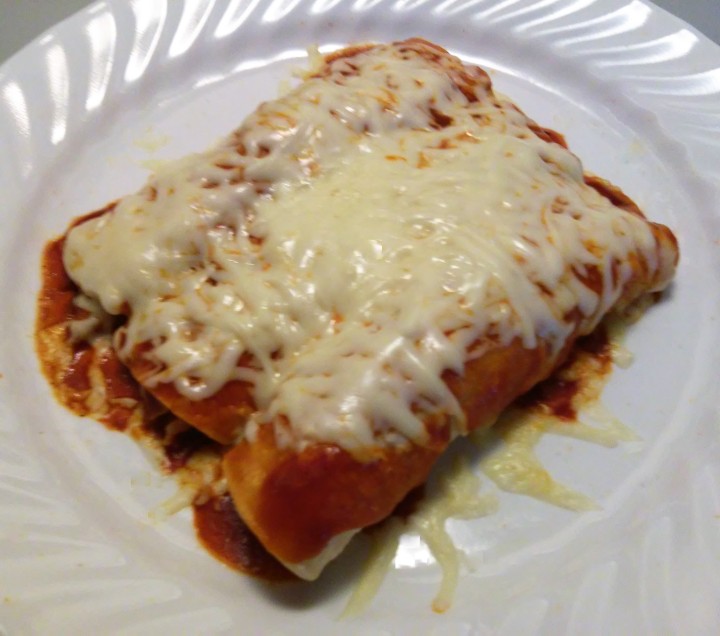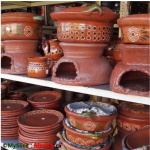
Over the centuries, the strong roots of Mexican cuisine have allowed the assimilation of foreign ingredients and techniques as part of its identity, without losing its distinctive national flavours. First, during colonial times, it was the introduction of unknown food products and crops from Spain, along with many Spanish recipes; later on, starting in the XIX Century, French and British influences could be appreciated in new versions of Mexican dishes, the adoption of pastries and the use of different meats and dairy products. A perfect example of this evolution in more recent times is enchiladas suizas (Swiss Enchiladas), said to have been named after this other European country because of the pristine white top, resembling the Alps (see photo above), or perhaps more likely because of Switzerland’s reputation as top producer of cream and cheese, key ingredients in the preparation of these enchiladas. The recipe resulted from the fusion of basic green enchiladas, a chicken filling, and generous amounts of cream and cheese; baking them to melt the cheese was the final touch of genius. The origin of enchiladas suizas is somewhat debated; I found several references, one edging on a manifesto, pinning the creation and naming of the dish to the Café Imperio, a family restaurant in the old neighbourhood of Tacuba, in Mexico City. That restaurant closed down, but the dish survived – a silent tribute to the success of this integration of flavours – and Swiss enchiladas appeared in the Jockey Club menu, during the time it was housed at La Casa de los Azulejos (1881-1914). As I have mentioned before, this historic building was purchased by the Sanborn brothers, and re-opened as a drugstore and tea room, moonlighting as a restaurant (since 1920). La Casa de los Azulejos became a UNESCO World Heritage site in 1987, with the Sanborn’s restaurant now being the most prominent part of the business; its menu, of course, has featured enchiladas suizas for decades.
Swiss Enchiladas – Enchiladas suizas
Printable recipe: Swiss Enchiladas
Ingredients (single portion)
3 corn tortillas
1 cup cooked chicken breast; shredded
1 ½ cups green tomatillo salsa (try my cooked green sauce recipe, or bottled)
½ cup cream (Mexican cream, or sour cream diluted with 2-3 tablespoons milk)
1 cup cheese (such as Oaxaca, Mexican manchego, friulano, mozzarella, etc.); shredded
Onion; thinly sliced (optional)
Warm tortillas as directed in the package (microwave or dry skillet). Place one tortilla in an oven-proof dish, fill with a third of the chicken and two tablespoons of sauce; roll, finishing with the tortilla end facing down. Repeat with the other tortillas; top with half of the remaining sauce*:
* Someone has mentioned (see comments at the end of the post) that the chicken was not warm enough after broiling the enchiladas; she saved her dinner by heating the enchiladas in the microwave oven, which worked well. I guess it depends on the broiler, and how far the enchiladas are from the heat source; my enchiladas were fine, but to avoid risk of this problem, a single portion of enchiladas may be microwaved for one minute at this point. Alternatively, before assembling the enchiladas, bring sauce to a simmer in a pan over low heat, and drop the shredded chicken in the sauce, pushing it down and to one side with a spoon; this will ensure the filling and sauce are nice and hot at serving time. Continue with recipe …
Sprinkle cheese, then distribute the rest of the sauce on top of the cheese:
Pour cream to completely cover enchiladas; bake under the broiler just until cheese melts:
Transfer to a dinner plate; top with onions (optional):

I prepared the enchiladas in a Pyrex™ glass dish to illustrate that several portions may be prepared at the same time, using a larger tray (10-12 enchiladas in a rectangular 9”x11”, for example). I do that for parties, but otherwise I bake individual portions in oven-proof dinner plates, to serve directly from the oven, and cater to specific preferences in my family (less sauce, more cheese, etc.)
For a slightly different way to prepare Swiss enchiladas, follow instructions as above, but after placing the rolled enchiladas in an oven-proof serving plate/dish, process the remaining sauce with the cream in a blender until a uniform mix is achieved:
Pour over enchiladas, top with cheese and bake as indicated in the recipe; serve (onions optional):

This method results in a more rugged surface, not pristine white as the first version, but gives the sauce a creamy texture that many people prefer. It really becomes a matter of taste; I like it this way, but my husband requests his portion with no cream at all.
Note: There are some claims that the original recipe used tomato-based red sauce, which along with the dairy evoked the colours of the Swiss flag and inspired the name; this seems a little bit of a stretch to me, because the dish was invented in Mexico City, where, as far as I have seen, they are always prepared with green sauce. I also think that an association to a foreign flag would have been unlikely. In addition, enchiladas in tomato-based sauce are usually called “entomatadas” (“in tomato”):

The enchiladas (entomatadas) above were filled with chicken and my red sauce with tomato, then topped with more sauce and a sprinkle of Oaxaca cheese. To melt the cheese, they may be broiled as before or – as I did for this plate – microwaved in high for one to two minutes.
I am joining Tummy Tuesday (this week with a recipe for easy and yummy spaghetti squash) graciously hosted by Mary @ Cactus Catz
I am also joining Fiesta Friday #245 hosted by Angie @ Fiesta Friday (another great fiesta, and kudos to her dog Skye, for earning her keep around the house); this week’s co-hosts are Liz @ spadesspatulasandspoons.com (yep, as the blog name indicates, Liz has lots of interesting stories on gardening and cooking) and Deb @ Pantry Portfolio (always about cooking with love and appreciation for life)
















Looks yummy. Will give it a try. Thanks for sharing
LikeLiked by 1 person
Thank you, I hope you like it!
LikeLiked by 1 person
Will try it.
LikeLiked by 1 person
Reblogged this on Thriving Not Surviving and commented:
Looks great!!
LikeLiked by 1 person
Thank you very much!
LikeLiked by 1 person
What a great post! I thought you were kidding! No matter what they’re called they look and sound fabulous.
LikeLiked by 1 person
Thank you, chef Mimi!
LikeLiked by 1 person
Dinner tonight!!
LikeLike
Great, let me know how it turned out!
LikeLiked by 1 person
Absolutely delicious!😋
The chicken wasn’t quite hot enough from the broiler, so I did nuke for a bit after.
LikeLiked by 1 person
Ah, good quick solution! Thanks for commenting on both the issue and your solution, in case other people are in the same situation. Maybe I should suggest warming up the sauce before assembling …
LikeLiked by 1 person
Nice and Easy. Yummy!
Do check out my easy and flavorful Milk Pudding on FieistaFriday #245
Thanks,
Rita
LikeLiked by 1 person
I thought you meant Swiss cheese, which I love! I wonder if it’s good with Swiss cheese?? I also love manchego, but haven’t tried Mexican manchego. Is there a difference? I like the recipe, Irene.
LikeLike
Hi, Angie! I think Swiss cheese might be an interesting twist, especially with the cream, it might work. Spanish Manchego, though, would not work at all, it is completely different from the Mexican one; Mexican Manchego is closer to friulano, good for melting in quesadillas, etc. La Mancha in Spain has a bone to pick with Mexico because of the name, since Manchego (the one from La Mancha) was granted Denomination of Origin in 1996, but Mexico had had its own “Manchego” for a long time before that, so Mexican companies have continued to use the name, maybe just adding a casual “Manchego style” label to avoid trouble. I am glad you liked the recipe, let me know if you get a chance to try it.
LikeLike